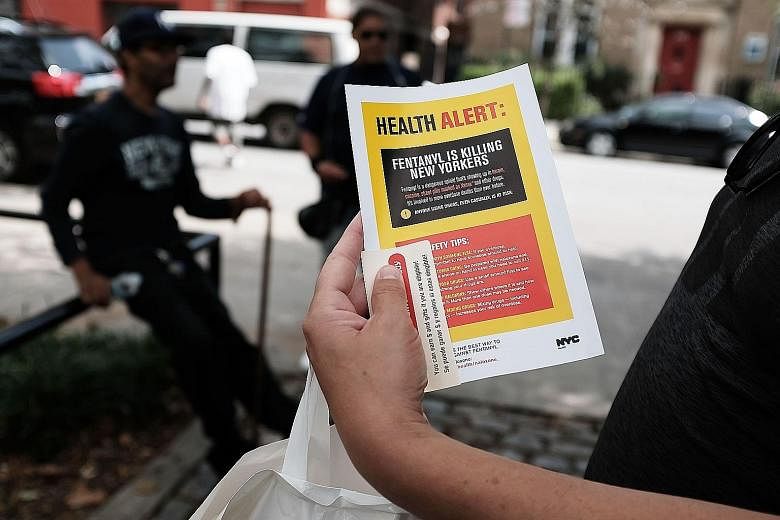On Sept 1 in Queens, New York, police on the midnight shift responded to a call about an apparently deranged man. They broke into an apartment to find 39-year- old Onix Morales covered in what appeared to be a white powder, which gave off a chemical odour.
Mr Morales was given a shot of nalaxone - an antidote for people overdosing on heroin - and carted to an ambulance.
The shot saved his life - but all eight officers on the midnight shift at the police station had to be hospitalised. The substance they had encountered was China White: heroin laced with deadly fentanyl.
Fentanyl is an opiate, or a drug derived from opium, made from chemical synthesis. It is much more powerful than morphine, so a tiny overdose can lead to death. Fentanyl is not sought by addicts, but is mixed with drugs such as heroin, like how methylated spirit is used to adulterate regular alcohol to give it extra kick and up its volume.
Fentanyl and its "analogues" or variants have become the main driver of thousands of deaths in an opioid overdose epidemic sweeping the United States.
Experts warn that, driven by high profits from mixing it into opioid painkillers and heroin, it is becoming more prevalent and threatens any country with a heroin addiction problem.
"It is not a matter of if it's coming into the market, it's a question of when," Mr Jeremy Douglas, regional head of the United Nations Office on Drugs and Crime (UNODC) in Bangkok, told The Straits Times. "The profitability is too great. We don't see organised crime ignoring profit potential in any country in the world."
The primary driver behind the flood of fentanyl is profit. Only a little fentanyl is needed for a lot of heroin or painkiller tablets.
"Back in 2014 or so, I calculated the mark-up for fentanyl trafficked from China and it was on the order of almost 200,000 per cent profit margin," said Dr Hakique Virani, an addiction specialist in Edmonton, Alberta, in Canada.
Additionally, a ready market exists - people using opioid painkillers or heroin. Deaths from fentanyl-associated overdoses have been seen across Europe and in Algeria, Morocco and Australia.
Most fentanyl and its "analogues" or variations come from China - though it is also starting to be synthesised in Mexico. In May 2015, Chinese Customs officers seized 46kg of fentanyl and 26kg of acetylfentanyl concealed in a container headed for Mexico. Six officials became ill and one fell into a coma after handling the drug.
The staggering profit from cutting relatively cheap fentanyl into opioid pills and heroin has led to a steep rise in deaths from overdoses.
Last month, The Washington Post reported that in 24 of the US' largest cities and the counties that surround them, fentanyl-related overdose deaths increased nearly 600 per cent from 2014 to last year - with 3,946 deaths. Officials expect even higher numbers this year.
In Canada, data suggests the number of overdose deaths this year has doubled or tripled from last year. According to one report, in the province of British Columbia alone, fentanyl was associated with 369 overdose deaths between January and April this year - up 115 per cent from the same period last year. "I don't see anything else but fentanyl," said Dr Virani. "This is the worst drug safety crisis we have ever seen."
Fentanyl is produced in China legally but is a controlled product. Yet, drug labs stay one step ahead by simply chemically tweaking the product, so that when one version is banned or controlled, they just produce a slightly different one.
"Very powerful analogues have emerged," Mr Douglas told The Straits Times over the phone. "Less than two months ago, one of my analysts, in a quick look online, took just 15 minutes to find a much more powerful version of fentanyl; it was not controlled and had literally just come out online. And it was on the open Internet."
After ordering online, supplies are shipped by regular courier in innocuous packages, often mislabelled, and will reach the buyer in a few days.
In a June report titled The Challenge Of Synthetic Drugs In East And South-east Asia, the UNODC warned that traffickers supplying East and South-east Asia, "where a considerable heroin market exists, may try to cut heroin with these highly potent substances to increase their profit margins".
"Given the limited forensic capacity of several countries in the region to identify these substances, such a development could go under reported," it said.
With the supply so difficult to stop, the only solution is to protect users through an enlightened public health approach, experts say.
"Treatment and harm reduction are the most important needs now," Dr Virani said.
In March, the US State Department's Bureau for International Narcotics and Law Enforcement Affairs said: "There is a growing international consensus that counter narcotics programmes must be designed and implemented with the aim of improving the health and safety of individuals."
Mr Douglas said: "Unfortunately, we are not going to be able to police our way out of demand. Part of it is supply reduction and law enforcement and intelligence sharing because organised crime needs to be stopped, but you also have to address the demand."

